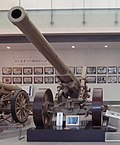Artillery of Japan
Artillery in Japan is recorded in the 13th century. It was not used widely before the Sengoku period in the 16th century.[1]
History
In the 1840s, the Tokugawa Shogunate began to anticipate that either British or French military might attack Japan. Takashima Shuhan (1798-1866) submitted a petition to the shogun calling for the purchase of Western firearms. In 1841, a demonstration of Western gunnery made a strong impression.[2] Powerful conservative factions in the shogunate resisted change.[3]
During the 1864 Bombardment of Shimonoseki, European naval guns were shown to be superior to Japanese cannon on shore.[4]
Following the Meiji Restoration, Japan would pursue a policy of "Rich country, strong army" (富国強兵), which led to a general rearmament.
Imperial Japanese Army
The Imperial Japanese Army (IJA) used artillery during the First Sino-Japanese War (1894–1895).
Naval guns and field artillery were important in the Russo-Japanese War of 1905.
Before and during World War II, the Japanese Army deployed a variety of artillery pieces.

The Imperial Japanese Navy (IJN) developed large naval artillery pieces.
Japan Self Defense Force (JSDF)
The self-propelled artillery of the current Japanese military include
Artillery Of Japan Media
A breech-loading swivel gun of Sengoku era. This gun is thought to have been cast in Portuguese Goa, India and used by famous Christian daimyo Ōtomo Sōrin. Caliber: 95mm, length: 2880mm
A bronze hand cannon that is thought to be originated from China.
Japanese artillery unit, at the Koishikawa arsenal, Tokyo, in 1882. Photographed by Hugues Krafft
Japan's main heavy artillery unit during the Second World War, the Type 89 15 cm Cannon
Related pages
References
- ↑ Perrin, Noel. (1979). Giving up the Gun, Japan's Reversion to the Sword, 1543-1879, p. 93.
- ↑ National Diet Library, "Acceptance of Western Military Science at the End of Edo Period, Land Wrfare Tactics"; retrieved 2012-2-22.
- ↑ Akamatsu, Paul. (2001). Meiji 1868: Revolution and Counter-revolution in Japan, PP. 50-51.
- ↑ Perrin, p. 76.
Further reading
- Evans, David C and Mark Peattie. (1997). Kaigun: strategy, tactics, and technology in the Imperial Japanese Navy, 1887–1941 Naval Institute Press, Annapolis, Maryland ISBN 0-87021-192-7
Other websites
| Wikimedia Commons has media related to Lua error in Module:Commons_link at line 62: attempt to index field 'wikibase' (a nil value).. |








